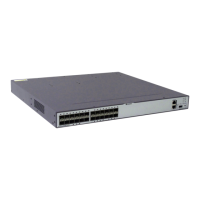For the configuration of the RD attribute filter, refer to the S6700 Series Ethernet Switches
Configuration Guide - VPN.
l Route-Policy
The Route-Policy is a complex filter. A Route-Policy is used to match certain route
attributes, and to change the route attributes when certain matching rules are met. The
Route-Policy uses the preceding filters to define its filtering rules.
A Route-Policy consists of multiple nodes. The relationship between the nodes is "OR".
The system checks the nodes in the routing policy, the node with the smaller value of node
is checked first. When the route matches a node in the routing policy, it passes the Route-
Policy and the system does not search the next matching node.
Each node comprises a set of if-match and apply clauses. The if-match clauses define the
matching rules. The matching objects are certain route attributes. The relationship between
if-match clauses in a node is "AND". A matching succeeds only when all the matching
rules specified by the if-match clauses in the same nod are matched.
The apply clauses specify actions. When a route matches a rule, the apply clause sets
certain attributes for the route. For the detailed configuration, refer to Configuring the
Route-Policy.
Application of the Routing Policy
The routing policy is used in the following situations:
l Import routes that meet the matching rules through filters when a routing protocol imports
routes discovered by other protocols.
l Filter routes that a routing protocol advertises or receives. Only the routes that meet the
matching rules are received or advertised.
For the configuration of routing policy applications, refer to the related routing protocol
configurations.
NOTE
After the routing policy changes, Routing Management Module (RM) immediately notifies various
protocols for processing by default.
10.3 Configuring the IP-Prefix List
An IP prefix list filters routes according to the destination addresses of the routes.
10.3.1 Establishing the Configuration Task
Before configuring the IP prefix list, familiarize yourself with the applicable environment,
complete the pre-configuration tasks, and obtain the required data. This can help you complete
the configuration task quickly and accurately.
Applicable Environment
Before applying a routing policy, you should set the matching rules, that is, filters. Compared
with an ACL, an IP prefix list is more flexible. When the IP prefix list is used to filter routes, it
matches the destination address of a route.
S6700 Series Ethernet Switches
Configuration Guide - IP Routing 10 Routing Policy Configuration
Issue 01 (2012-03-15) Huawei Proprietary and Confidential
Copyright © Huawei Technologies Co., Ltd.
594

